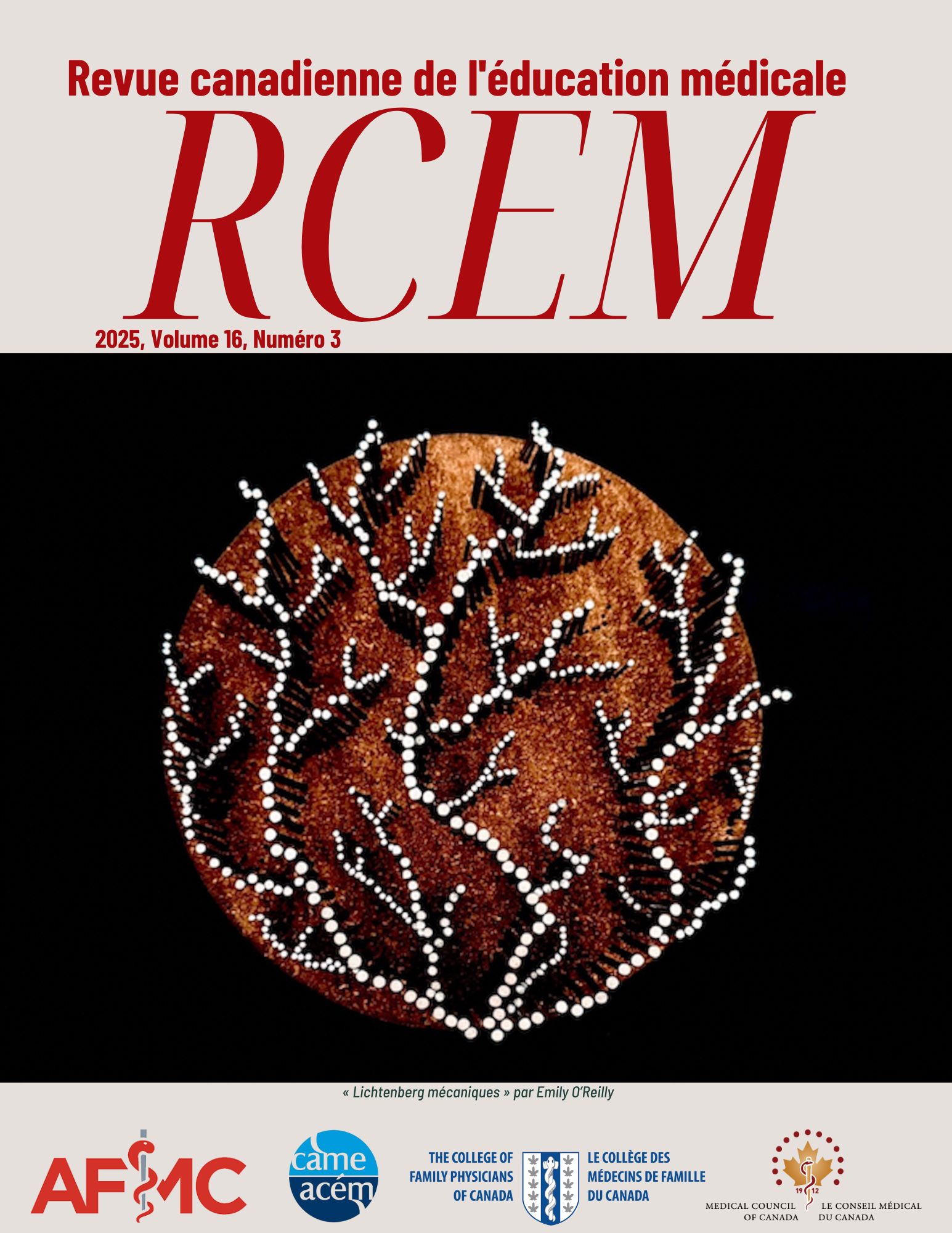Sept façons de gérer les demandes d’avertissements de contenu en formation médicale
DOI :
https://doi.org/10.36834/cmej.79544Résumé
Les avertissements de contenu sont des énoncés présentés avant la diffusion de contenus sensibles, visant à préparer les destinataires à une détresse éventuelle. Ces dernières années, des appels ont été lancés pour intégrer ces avertissements dans la formation médicale, en raison de la reconnaissance croissante que l’exposition à des contenus sensibles en contexte éducatif peut accentuer le stress vécu par les étudiants en médecine. Les données probantes sur leur utilité sont contradictoires, et il n’existe actuellement aucun consensus quant à la façon d’introduire ces avertissements dans les milieux éducatifs — ni même sur l’opportunité de le faire. Dans cet article, nous présentons sept façons de mieux gérer les demandes d’avertissements de contenu en formation médicale : consulter son établissement ; adopter une approche équilibrée et fondée sur les données probantes ; encourager la conscience de soi et la recherche d’aide ; communiquer des attentes réalistes quant à la pratique clinique ; aborder les contenus sensibles comme des occasions d’apprentissage ; favoriser l’inclusivité dans les discussions portant sur des sujets sensibles ; et encourager la rétroaction.
Téléchargements
Références
1. Nolan HA, Roberts L. Twelve tips for implementing trigger or content warnings in healthcare professions education. Med Teach. Published online Dec 17,2023;1-8. https://doi.org/10.1080/0142159X.2023.2290995 DOI: https://doi.org/10.1080/0142159X.2023.2290995
2. Stout J, Martin AI. Trauma-informed care in the classroom: our experience with a content warning in a medical school course. Med Sci Educ. 2022;32(3):711-718. https://doi.org/10.1007/s40670-022-01559-0 DOI: https://doi.org/10.1007/s40670-022-01559-0
3. Halperin SJ, Henderson MN, Prenner S, Grauer JN. Prevalence of anxiety and depression among medical students during the Covid-19 pandemic: a cross-sectional study. J Med Educ Curric Dev. 2021;8:238212052199115. https://doi.org/10.1177/2382120521991150 DOI: https://doi.org/10.1177/2382120521991150
4. Brazeau CMLR, Shanafelt T, Durning SJ, et al. Distress among matriculating medical students relative to the general population. Acad Med J Assoc Am Med Coll. 2014;89(11):1520-1525. https://doi.org/10.1097/ACM.0000000000000482 DOI: https://doi.org/10.1097/ACM.0000000000000482
5. Rotenstein LS, Ramos MA, Torre M, et al. Prevalence of depression, depressive symptoms, and suicidal ideation among medical students. JAMA. 2016;316(21):2214-2236. https://doi.org/10.1001/jama.2016.17324 DOI: https://doi.org/10.1001/jama.2016.17324
6. Bridgland VME, Jones PJ, Bellet BW. A meta-analysis of the efficacy of trigger warnings, content warnings, and content Notes. Clin Psychol Sci. Published online August 18, 2023:21677026231186625. https://doi.org/10.1177/21677026231186625 DOI: https://doi.org/10.31219/osf.io/qav9m
7. Nolan HA, Roberts L. Trigger warnings as tools for learning—theorising an evolving cultural concept. Med Educ. 2024;58(2):185-195. https://doi.org/10.1111/medu.15172 DOI: https://doi.org/10.1111/medu.15172
8. Hu B, Yang X, Tuo X. The prevalence of post-traumatic stress disorder in college students by continents and national income during the COVID-19 pandemic: a meta-analysis. Front Psychol. 2023;14:1129782. https://doi.org/10.3389/fpsyg.2023.1129782 DOI: https://doi.org/10.3389/fpsyg.2023.1129782
9. Nolan HA, Roberts L. Medical educators’ views and experiences of trigger warnings in teaching sensitive content. Med Educ. 2021;55(11):1273-1283. https://doi.org/10.1111/medu.14576 DOI: https://doi.org/10.1111/medu.14576
10. Beverly EA, Díaz S, Kerr AM, Balbo JT, Prokopakis KE, Fredricks TR. Students’ perceptions of trigger warnings in medical education. Teach Learn Med. 2018;30(1):5-14. https://doi.org/10.1080/10401334.2017.1330690 DOI: https://doi.org/10.1080/10401334.2017.1330690
11. Nolan HA, Roberts L. Medical students’ views on the value of trigger warnings in education: a qualitative study. Med Educ. 2022;56(8):834-846. https://doi.org/10.1111/medu.14803 DOI: https://doi.org/10.1111/medu.14803
Téléchargements
Publié-e
Comment citer
Numéro
Rubrique
Licence
© Victoria Taylor, Lara Hazelton, Kathleen Singh 2025

Cette œuvre est sous licence Creative Commons Attribution - Pas d'Utilisation Commerciale - Pas de Modification 4.0 International.
La soumission d’un manuscrit original à la revue constitue une indication qu’il s’agit d’un travail original, qu’il n’a jamais été publié et qu’il n’est pas envisagé pour publication dans une autre revue. S’il est accepté, il sera publié en ligne et ne pourra l’être ailleurs sous la même forme, à des fins commerciales, dans quelque langue que ce soit, sans l’accord de l’éditeur.
La publication d’une recherche scientifique a pour but la diffusion de connaissances et, sous un régime sans but lucratif, ne profite financièrement ni à l’éditeur ni à l’auteur.
Les auteurs qui publient dans la Revue canadienne d’éducation médicale acceptent de publier leurs articles sous la licence Creative Commons Paternité - Pas d’utilisation commerciale, Pas de modification 4.0 Canada. Cette licence permet à quiconque de télécharger et de partager l’article à des fins non commerciales, à condition d’en attribuer le crédit aux auteurs. Pour plus de détails sur les droits que les auteurs accordent aux utilisateurs de leur travail, veuillez consulter le résumé de la licence et la licence complète.











